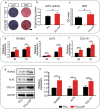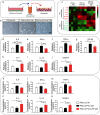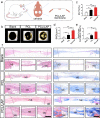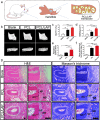Nanosilicate-functionalized nanofibrous membrane facilitated periodontal regeneration potential by harnessing periodontal ligament cell-mediated osteogenesis and immunomodulation
- PMID: 37443072
- PMCID: PMC10339597
- DOI: 10.1186/s12951-023-01982-4
Nanosilicate-functionalized nanofibrous membrane facilitated periodontal regeneration potential by harnessing periodontal ligament cell-mediated osteogenesis and immunomodulation
Abstract
Although various new biomaterials have enriched the methods for periodontal regeneration, their efficacy is still controversial, and the regeneration of damaged support tissue in the periodontium remains challenging. Laponite (LAP) nanosilicate is a layered two-dimensional nanoscale, ultrathin nanomaterial with a unique structure and brilliant biocompatibility and bioactivity. This study aimed to investigate the effects of nanosilicate-incorporated PCL (PCL/LAP) nanofibrous membranes on periodontal ligament cells (PDLCs) in vitro and periodontal regeneration in vivo. A PCL/LAP nanofibrous membrane was fabricated by an electrospinning method. The characterization of PCL/LAP nanofibrous membrane were determined by scanning electron microscopy (SEM), energy dispersive spectrum of X-ray (EDS), inductively coupled plasma mass spectrometry (ICP-MS) and tensile test. The proliferation and osteogenic differentiation of PDLCs on the PCL/LAP nanofibrous membrane were evaluated. A PDLCs and macrophage coculture system was used to explore the immunomodulatory effects of the PCL/LAP nanofibrous membrane. PCL/LAP nanofibrous membrane was implanted into rat calvarial and periodontal defects, and the regenerative potential was evaluated by microcomputed topography (micro-CT) and histological analysis. The PCL/LAP nanofibrous membrane showed good biocompatibility and bioactivity. It enhanced the proliferation and osteogenic differentiation of PDLCs. The PCL/LAP nanofibrous membrane also stimulated anti-inflammatory and pro-remodeling N2 neutrophil formation, regulated inflammatory responses and induced M2 macrophage polarization by orchestrating the immunomodulatory effects of PDLCs. The PCL/LAP nanofibrous membrane promoted rat calvarial defect repair and periodontal regeneration in vivo. LAP nanosilicate-incorporated PCL membrane is capable of mediating osteogenesis and immunomodulation of PDLCs in vitro and accelerating periodontal regeneration in vivo. It could be a promising biomaterial for periodontal regeneration therapy.
Keywords: Immunomodulation; Nanosilicate; Osteogenesis; Periodontal ligament; Periodontal regeneration.
© 2023. The Author(s).
Conflict of interest statement
The authors declare that they have no known competing financial interests or personal relationships that could have appeared to influence the work reported in this paper
Figures









Similar articles
-
Nanosilicates facilitate periodontal regeneration potential by activating the PI3K-AKT signaling pathway in periodontal ligament cells.J Nanobiotechnology. 2024 Sep 3;22(1):532. doi: 10.1186/s12951-024-02798-6. J Nanobiotechnology. 2024. PMID: 39223550 Free PMC article.
-
Nanosilicate-Functionalized Polycaprolactone Orchestrates Osteogenesis and Osteoblast-Induced Multicellular Interactions for Potential Endogenous Vascularized Bone Regeneration.Macromol Biosci. 2022 Feb;22(2):e2100265. doi: 10.1002/mabi.202100265. Epub 2021 Nov 8. Macromol Biosci. 2022. PMID: 34705332
-
Vascularized bone regeneration accelerated by 3D-printed nanosilicate-functionalized polycaprolactone scaffold.Regen Biomater. 2021 Nov 12;8(6):rbab061. doi: 10.1093/rb/rbab061. eCollection 2021 Dec. Regen Biomater. 2021. PMID: 34858634 Free PMC article.
-
Guidance on the assessment of the functionality of biomaterials for periodontal tissue regeneration: Methodologies and testing procedures.Dent Mater. 2025 Mar;41(3):306-318. doi: 10.1016/j.dental.2024.12.018. Epub 2025 Jan 16. Dent Mater. 2025. PMID: 39824690 Review.
-
Immunomodulation for Tissue Repair and Regeneration.Tissue Eng Regen Med. 2023 Jun;20(3):389-409. doi: 10.1007/s13770-023-00525-0. Epub 2023 Mar 15. Tissue Eng Regen Med. 2023. PMID: 36920675 Free PMC article. Review.
Cited by
-
Applications and interventions of polymers and nanomaterials in alveolar bone regeneration and tooth dentistry.RSC Adv. 2024 Nov 12;14(49):36226-36245. doi: 10.1039/d4ra06092j. eCollection 2024 Nov 11. RSC Adv. 2024. PMID: 39534053 Free PMC article. Review.
-
Zwitterion nanocomposite hydrogels with bioactivity and anti-adhesion properties for rapid prevention of postoperative and recurrent adhesion.Mater Today Bio. 2025 Apr 28;32:101811. doi: 10.1016/j.mtbio.2025.101811. eCollection 2025 Jun. Mater Today Bio. 2025. PMID: 40391019 Free PMC article.
-
Electrospun Nanofibers for Biomedical, Sensing, and Energy Harvesting Functions.Polymers (Basel). 2023 Oct 29;15(21):4253. doi: 10.3390/polym15214253. Polymers (Basel). 2023. PMID: 37959933 Free PMC article. Review.
-
Evaluation of the Efficacy of Stem Cells Therapy in the Periodontal Regeneration: A Meta-Analysis and Mendelian Randomization Study.Stem Cell Rev Rep. 2024 May;20(4):980-995. doi: 10.1007/s12015-024-10690-x. Epub 2024 Feb 22. Stem Cell Rev Rep. 2024. PMID: 38388709 Review.
-
Xenogenous implanted dental follicle stem cells promote periodontal regeneration through inducing the N2 phenotype of neutrophils.Stem Cell Res Ther. 2024 Aug 26;15(1):270. doi: 10.1186/s13287-024-03882-2. Stem Cell Res Ther. 2024. PMID: 39183362 Free PMC article.
References
MeSH terms
Substances
Grants and funding
LinkOut - more resources
Full Text Sources
Research Materials

